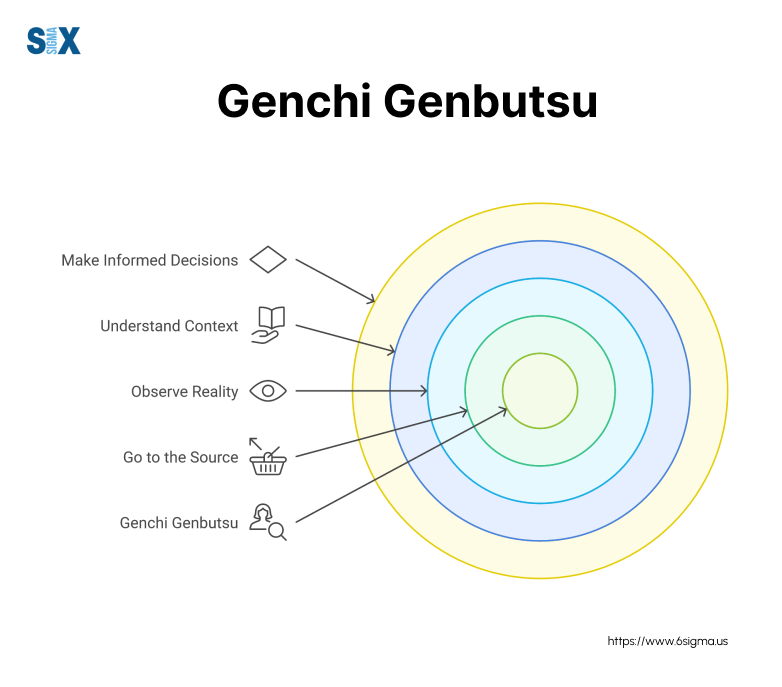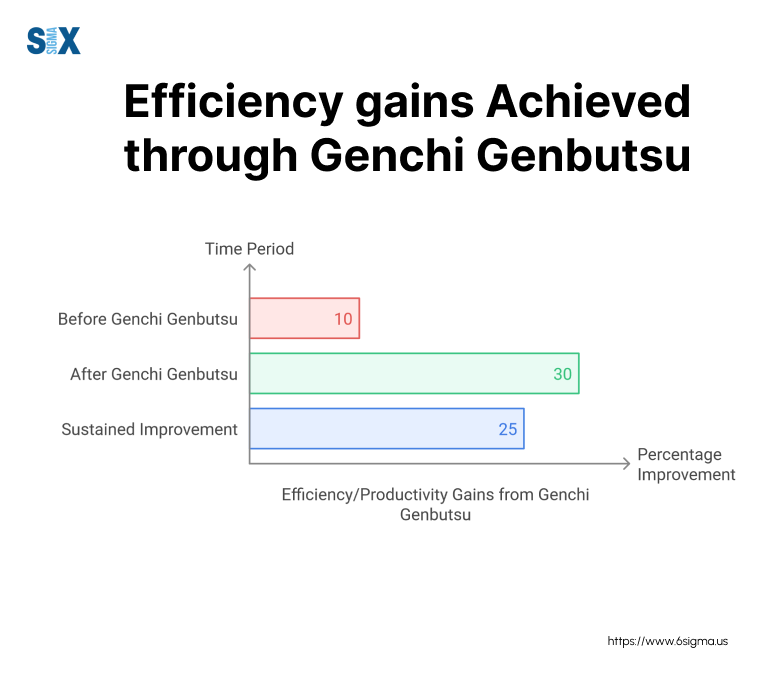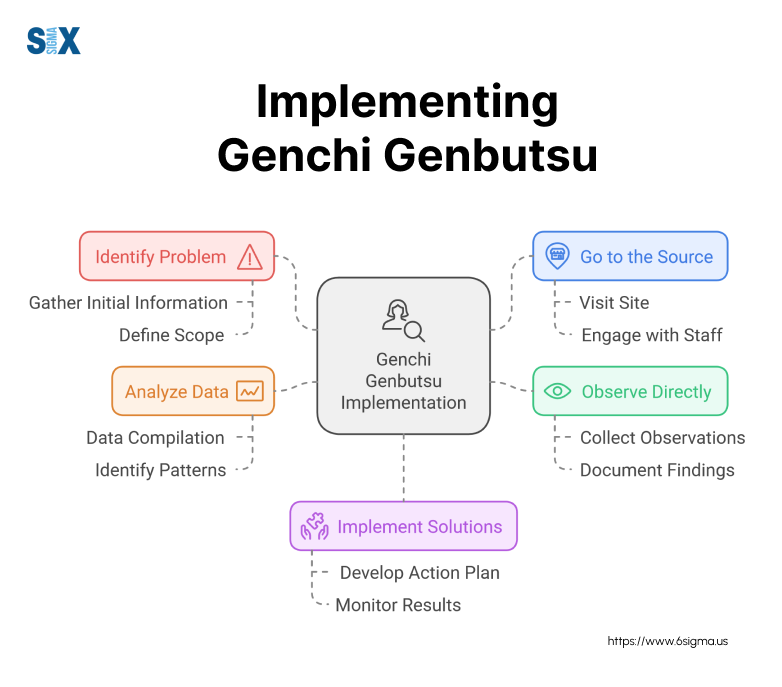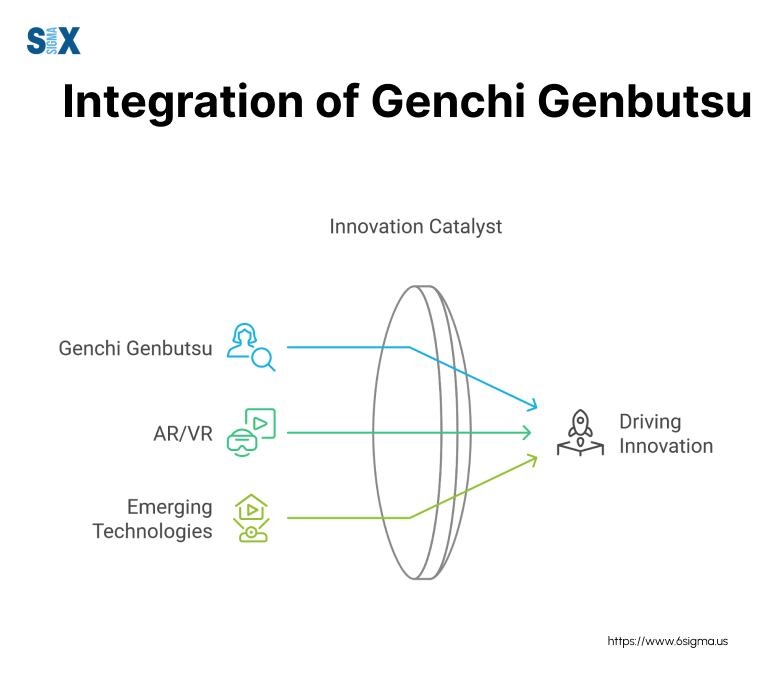Genchi Genbutsu: A Way to First-Hand Process Observation
Imagine you’re a business leader faced with a persistent operational issue that’s hurting productivity and customer satisfaction.
You’ve pored over reports, analyzed data, and held countless meetings, yet the root cause remains elusive.
This disconnect between perception and reality is a common challenge that the Japanese philosophy of “genchi genbutsu” can help overcome.
Genchi genbutsu, which literally translates to “go and see for yourself“, is a core principle of the renowned Toyota Production System.
Pioneered by the visionary Taiichi Ohno, genchi genbutsu challenges leaders to step away from their desks and immerse themselves in the gemba (the “real place” where value creation happens).
By doing so, they can bridge the gap between theory and reality, gain invaluable insights, and develop more informed, effective solutions.
Key Highlights
- Impact genchi genbutsu
- Core principles
- Implementation strategies
- Creative ways to adapt this approach
The Foundations of Genchi Genbutsu
The philosophy of “genchi genbutsu” is deeply rooted in the Toyota Production System (TPS) and the company’s relentless pursuit of operational excellence.
Developed by the Japanese automotive giant in the mid-20th century, this revolutionary approach to manufacturing aimed to eliminate waste and inefficiencies through continuous improvement and respect for people.
At the core of the Toyota Way lies the principle of “go and see” – the essence of genchi genbutsu.
It emphasizes the importance of directly observing processes, problems, and work environments firsthand, rather than relying solely on reports, data, or assumptions.
This hands-on approach is inextricably linked to the TPS pillars of lean manufacturing and kaizen (continuous improvement).
A prime example of genchi genbutsu in action within Toyota is the story of the 2004 Sienna minivan redesign. Yuji Yokoya, the chief engineer, embarked on an epic journey, driving a Sienna across all 50 U.S. states and through Canada and Mexico.
This firsthand experience allowed him to uncover crucial insights, such as the need for more cup holders to accommodate the Western habit of eating in vehicles – a detail that might have been overlooked without direct observation.

Taiichi Ohno’s Teachings on Genba Observation
While genchi genbutsu became a fundamental part of the Toyota Way, its roots can be traced back to the visionary Taiichi Ohno, widely regarded as the father of the Toyota Production System.
Ohno was a firm believer in the power of direct observation and immersion in the gemba.
In his teachings, Ohno emphasized the importance of leaders and managers “going to the source” to fully understand processes, problems, and the realities faced by frontline workers.
He famously instructed new engineers at Toyota to spend their first day on the production floor, carefully observing every aspect of the work and reporting their findings back to him.
Ohno’s rationale was simple: while reports and data are valuable tools, they can never fully capture the nuances and complexities of real-world operations.
Only by directly witnessing processes and engaging with workers could leaders gain the deep insights needed to drive meaningful improvements.
Transform your problem-solving approach wit our Yellow Belt course which equips you with essential tools like genchi genbutsu to drive continuous improvement and operational excellence
Profound Business Benefits of Genchi Genbutsu
It’s tempting to rely heavily on reports, metrics, and dashboards to inform decisions and drive improvements.
However, the genchi genbutsu philosophy challenges this assumption, recognizing the limitations of secondhand information and the value of firsthand observation.
By encouraging leaders and teams to “go and see” (the literal meaning of genchi genbutsu), organizations can bridge the gap between perceived reality and ground truth.
Reports and data, while valuable, often fail to capture the nuances, complexities, and human elements that shape real-world processes and challenges.
For example, a manufacturing facility might analyze production data and conclude that a particular assembly line is underperforming.
However, by practicing genchi genbutsu and directly observing the line, the team may uncover factors that data alone cannot reveal – ergonomic issues, material flow bottlenecks, or even miscommunication among workers.
Without this direct observation and immersion in the gemba (the actual workplace), organizations risk making decisions based on incomplete information, potentially leading to ineffective solutions or unintended consequences.

Unlocking Process Improvements
One of the core objectives of genchi genbutsu is to identify opportunities for process improvements and waste reduction.
By witnessing processes firsthand, teams can pinpoint the root causes of issues, inefficiencies, and bottlenecks that may have gone unnoticed through traditional reporting channels.
Armed with this deeper understanding, organizations can develop targeted, well-informed solutions that address the true underlying problems, rather than merely treating symptoms.
This approach has proven to drive significant gains in efficiency, productivity, and quality across various industries.
Fostering Employee Empowerment
Beyond process optimization, genchi genbutsu plays a crucial role in fostering a culture of employee engagement, empowerment, and continuous improvement.
By involving frontline workers in the observation process and actively seeking their insights, organizations demonstrate respect for their expertise and experience.
This approach not only uncovers valuable perspectives that might otherwise be overlooked but also cultivates a sense of ownership and accountability among employees.
When workers feel heard and valued, they are more likely to embrace change, contribute ideas, and take an active role in driving improvements.
Companies like Toyota have long recognized the power of this approach, encouraging all levels of the organization to practice genchi genbutsu and engage in problem-solving.
This collective effort has enabled Toyota to maintain its position as a leader in operational excellence and innovation.
Implementing Genchi Genbutsu: Step-by-Step
While the philosophy of genchi genbutsu is simple in theory – “go and see” – putting it into practice requires a structured and purposeful approach.
Here’s a step-by-step guide to help you effectively implement this powerful lean methodology within your organization.

Step 1: Identify the Process/Area
The first step in the genchi genbutsu journey is to pinpoint the specific process, workflow, or area that you want to observe and improve.
This could be an assembly line, a service operation, or even an administrative function that seems ripe for optimization.
Techniques like value stream mapping, process analysis, and data analysis can help you identify potential opportunities and prioritize areas based on factors such as impact, complexity, and alignment with organizational goals.
Step 2: Plan Your Gemba Walk
With the target area identified, it’s time to structure your gemba walk – the act of going to the actual place (gemba) where work happens.
Effective planning is crucial to ensure a productive and insightful observation experience.
Key considerations include:
- Timing: Choose a time when the process is running at a typical level, avoiding atypical conditions.
- Team: Assemble a cross-functional team with diverse perspectives and expertise.
- Scope: Clearly define the boundaries of what you’ll be observing and the specific goals of the walk.
- Approach: Decide on the observation methods you’ll use, such as shadowing workers, taking notes, or recording video/audio.
Planning tools like gemba walk checklists can help you organize and prepare for a successful observation session.
Step 3: Go to Gemba and Observe
With your plan in place, it’s time to put the genchi genbutsu principle into action – go to the gemba and observe.
This step is where the true power of firsthand observation comes into play.
As you witness the process unfold, maintain an open and inquisitive mindset. Actively observe the work, the movements, the interactions, and the environment.
Engage your senses – sight, sound, smell – to pick up on nuances that data alone cannot convey.
Collect data through note-taking, photos, videos, and even time studies if appropriate. But remember, the goal isn’t just to gather information – it’s to fully immerse yourself in the experience and gain a deep understanding of the realities on the ground.
Involving frontline workers in the observation process is also crucial.
They are the true experts in their roles, and their insights can shed light on issues, bottlenecks, and improvement opportunities that may not be immediately apparent.
Step 4: Analyze Findings and Develop Solutions
With your firsthand observations and data in hand, it’s time to collaborate with your team and analyze the findings.
Collectively identify the root causes of any issues or inefficiencies you witnessed, leveraging the diverse perspectives and expertise within your group.
Once you have a clear understanding of the underlying problems, work together to develop targeted solutions that address the root causes.
Draw upon lean principles, best practices, and creative thinking to craft innovative approaches that can drive meaningful improvements.
Take your continuous improvement skills to the next level. Learn to develop and integrate comprehensive lean strategies like genchi genbutsu in our comprehensive Green Belt program.
Creative Applications of Genchi Genbutsu
While genchi genbutsu is deeply rooted in lean manufacturing principles, its power transcends the factory floor.
Forward-thinking organizations across various industries are finding innovative ways to apply this philosophy, often combining it with other cutting-edge methodologies and emerging technologies.
Combining with Other Methodologies
The insights gained through genchi genbutsu can be a powerful complement to other widely-adopted business frameworks and practices.
For example, Design Thinking – a human-centered approach to problem-solving – relies heavily on deep user observation and empathy.
By incorporating genchi genbutsu principles, Design Thinking teams can gain richer, more authentic insights into user experiences, behaviors, and pain points.
Similarly, organizations embracing Agile methodologies can leverage genchi genbutsu to enhance their processes.
Agile teams can conduct gemba walks to better understand workflow bottlenecks, communication breakdowns, or other issues hindering their productivity and collaboration.
A prime example of this powerful combination is Menlo Innovations, a software company that has fully integrated genchi genbutsu into its Agile practices.
Developers and project teams regularly observe each other’s work, fostering continuous learning, improvement, and alignment with customer needs.
Using Emerging Technologies
As organizations evolve digitally, new technologies are enabling innovative applications of the genchi genbutsu philosophy.
The rise of the Internet of Things (IoT), for instance, has equipped factories and workplaces with a vast array of sensors and data streams, providing unprecedented visibility into processes and operations.
By leveraging advanced analytics and artificial intelligence (AI), organizations can analyze this data to identify areas that may benefit from firsthand observation and targeted improvements.
This technology-driven approach can help prioritize and guide genchi genbutsu efforts, making them more efficient and impactful.
Fostering a Genchi Genbutsu Culture
Ultimately, the true power of genchi genbutsu lies in fostering a culture where “going and seeing” becomes an ingrained mindset throughout the organization.
Companies like Toyota have embedded this philosophy so deeply that it permeates every level, from executives to frontline workers.
By encouraging employees to proactively observe processes, ask questions, and challenge assumptions, organizations can unlock a continuous cycle of improvement and innovation.
This culture empowers individuals to take ownership, surface issues, and collaboratively develop solutions based on firsthand insights.
Companies like W.L. Gore & Associates, known for their innovative culture, have embraced genchi genbutsu wholeheartedly.
Their employees are actively encouraged to immerse themselves in different roles, functions, and environments – fostering a deep understanding of the organization’s operations and facilitating cross-pollination of ideas.

Become a lean expert! Our Black Belt course prepares you to lead organization-wide initiatives and drive strategic excellence through advanced lean techniques like genchi genbutsu and emerging technologies.
Start Your Genchi Genbutsu Journey
Throughout this comprehensive guide, we’ve explored the powerful philosophy of genchi genbutsu – the Japanese principle of “go and see” that has transformed organizations across the globe.
From its origins within the Toyota Production System to its modern-day applications leveraging cutting-edge technologies, genchi genbutsu has proven itself as a catalyst for continuous improvement, innovation, and operational excellence.
Through step-by-step guidance you now have a clear roadmap for implementing genchi genbutsu within your organization, regardless of industry or scale.
The journey towards operational excellence is never-ending, but genchi genbutsu provides a potent tool for driving meaningful change.
Embrace this philosophy, and you’ll unlock a world of continuous learning, empowerment, and innovation that can propel your organization to new heights of success.
SixSigma.us offers both Live Virtual classes as well as Online Self-Paced training. Most option includes access to the same great Master Black Belt instructors that teach our World Class in-person sessions. Sign-up today!
Virtual Classroom Training Programs Self-Paced Online Training Programs






